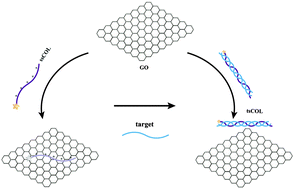A highly specific graphene platform for sensing collagen triple helix†
Abstract
The construction of simple and efficient assays to detect collagen biomarkers plays a critical role in developing novel diagnosis and therapies for the highly prevalent chronic fibroproliferative diseases. Inspired by the successful development of various GO-based biosensors for DNA utilizing its well-known double helix structure, we have for the first time created a highly specific GO platform for sensing the collagen triple helix. We have designed a dye-labeled single stranded collagen (ssCOL) peptide probe to target a complementary single stranded collagen peptide sequence. We have revealed that GO binds with the ssCOL probe and quenches the fluorescence of the dye, while the hybridization of the ssCOL probe with its target collagen peptide GPO results in the retention of the fluorescence of the probe. We have demonstrated that this design provides a fluorescence-enhanced assay that is sensitive and selective to the target collagen peptide with little interferences from other proteins, and it can be applied for quantitative detection in complex biological fluids. These results indicate that this GO-based ssCOL platform has great potential in molecular diagnostics of fibroproliferative diseases. It may provide a novel strategy to construct efficient assays for the proteins containing triple helix motifs such as collectins, adiponectin, macrophage scavenger and C1q.

- This article is part of the themed collection: 2016 Journal of Materials Chemistry B Hot Papers

 Please wait while we load your content...
Please wait while we load your content...